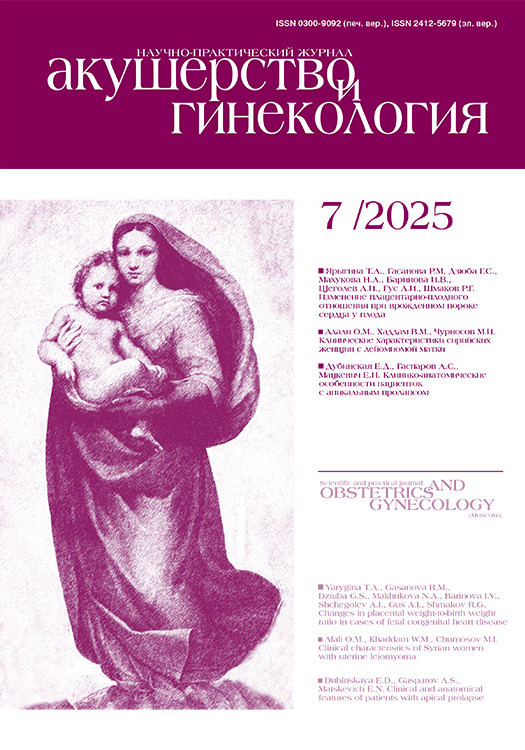Surgical treatment of a vesico-uterine fistula after cesarean section
Kozachenko A.V., Shatylko T.V., Dzhabiev A.V., Latfullina E.Z.
Relevance: The article discusses the diagnosis and surgical treatment of a complex obstetric complication, namely vesico-uterine fistula after cesarean section (Youssef’s syndrome), with a minimally invasive access and modern medical technologies. Vesico-uterine fistula is usually a complication of surgical delivery or pathological delivery and it accounts for up to 9% of all urogynecological fistulas. The article presents the analysis of modern literature on genitourinary fistulas and a clinical observation of a vesico-uterine fistula in a 38-year-old patient.
Case report: The patient presented with hypomenorrhea and cyclic discharge of urine with blood during menstruation, periodic pain in the lower abdomen. In addition to standard visual diagnostic techniques, such as ultrasound and MRI, an office cystoscopy was performed to diagnose a fistula. The vesico-uterine fistula was sutured using laparoscopic access, with simultaneous metroplasty performed using fibrin glue. The long-term results of the operation were assessed after 4 months; the patient had no problems with urination; the thickness of the myometrium in the metroplasty area was 4 mm.
Conclusion: In order to prevent the development of a vesico-uterine fistula during cesarean section, it is necessary to perform the bladder mobilization. The vesico-uterine fistula should be sutured by a multidisciplinary surgical team with the participation of a urologist.
Authors’ contributions: Kozachenko A.V., Shatylko T.V., Dzhabiev A.V. – collecting and processing the material during the clinical examination and treatment of the patient; Kozachenko A.V., Latfullina E.Z. – writing and editing the article, making video presentation of the operation.
Conflicts of interest: Authors declare lack of the possible conflicts of interest.
Funding: The study was conducted without sponsorship.
Patient Consent for Publication: The patient signed informed consent for the publication of her data and associated images in an impersonal form.
For citation: Kozachenko A.V., Shatylko T.V., Dzhabiev A.V., Latfullina E.Z.
Surgical treatment of a vesico-uterine fistula after cesarean section.
Akusherstvo i Ginekologiya/Obstetrics and Gynecology. 2025; (7): 188-192 (in Russian)
https://dx.doi.org/10.18565/aig.2025.76
Keywords
References
- Caraman R., Toma A., Balescu I., Stiru O., Savu C., Diaconu C. et al. Vesico-uterine fistula following c-section – a case report and literature review. In Vivo. 2022; 36(1): 528-32. https://dx.doi.org/10.21873/invivo.12734
- Richter L.A., Lee H., Nishimwe A., Niteka L.C., Kielb S.J. et al. Characteristics of genitourinary fistula in Kigali, Rwanda; 5-year trends. Urology. 2021; 150: 165-9. https://dx.doi.org/10.1016/j.urology.2020.05.077
- Holme A., Breen M., MacArthur C. Obstetric fistulae: a study of women managed at the Monze Mission Hospital, Zambia. BJOG. 2007; 114(8): 1010-7. https://dx.doi.org/10.1111/j.1471-0528.2007.01353.x
- Rasekhjahromi A., Chitrani Z., Khlili A., Babaarabi Z.Z. Complications associated with intravesical migration of an intrauterine device. Obstet. Gynecol. Sci. 2020; 63(5): 675-8. https://dx.doi.org/10.5468/ogs.19105
- Briceno S.A., Brown M.R., Herson A.B., Fischer S.T., Healey K.D., Miller B.T. et al. Long-term retained lippes loop intrauterine device causes vesicouterine fistula. Cureus. 2023; 15(4): e38217. https://dx.doi.org/10.7759/cureus.38217
- Paluku J.L., Furaha C.M., Bartels S.A., Aksanti B.K., Kataliko B.K., Kasereka J.M. et al. Obstetric vesico-uterine fistula in nine reference hospitals in the Democratic Republic of the Congo: epidemiological, clinical, and therapeutic aspects. BMC Women’s Health. 2024; 24(1): 309. https://dx.doi.org/10.1186/s12905-024-03124-w
- Yin S., Chen L., Zhou Y., Yuan P., Guo X. , Lu J. et al. Evaluation of cesarean rates for term, singleton, live vertex deliveries in China in 2020 among women with no prior cesarean delivery. JAMA Netw. Open. 2023; 6(3): e234521. https://dx.doi.org/10.1001/jamanetworkopen.2023.4521
- Cavoretto P.I., Candiani M., Farina A. Cesarean delivery uptake trends associated with patient features and threshold for labor anomalies. JAMA Netw. Open. 2023; 6(3): e235436. https://dx.doi.org/10.1001/jamanetworkopen.2023.5436
- Rydahl E., Declercq E., Juhl M., Maimburg R.D. Cesarean section on a rise-does advanced maternal age explain the increase? A population register-based study. PLOS One. 2019; 14(1): e0210655. https://dx.doi.org/10.1371/journal.pone.0210655
- Bonavina G., Busnelli A., Acerboni S., Martini A., Candiani M., Bulfoni A. et al. Surgical repair of post-cesarean vesicouterine fistula: a systematic review and a plea for prevention. Int. J. Gynaecol. Obstet. 2024; 165(3): 894-915. https://dx.doi.org/10.1002/ijgo.15256
- Byamukama O., Tarnay C., Ainomugisha B., Tibaijuka L., Kajabwangu R., Kalyebara P.K. et al. Iatrogenic female genitourinary fistula in Uganda: etiology, twelve-year trends, and risk factors for development following cesarean section. Int. J. Womens Health. 2024; 16: 1865-73. https://dx.doi.org/10.2147/IJWH.S473024.
- Mishra V., Pandey H., Shekhar S., Sharma C. Incidentally diagnosed type 2 Youssef's syndrome with migrated postcesarean postpartum intrauterine contraceptive device. Gynecol. Minim. Invasive Ther. 2022; 11(1): 67-9. https://dx.doi.org/10.41.03/GMIT.GMIT_107_20
- Yan Z.P., Wang C.C., Wang Y.Y., Zhao S.T. A case with type II vesicouterine fistula. Clin. Case Rep. 2022; 10(2): e05284. https://dx.doi.org/10.1002/ccr3.5284
- Rahmita M.M., Rodjani A., Wahyudi I., Widia F. Rare cases of vesicouterine fistula. Low Urin. Tract Symptoms. 2022; 14(5): 401-4. https://dx.doi.org/10.1111/luts.12440
- Govorov I.E., Vorobeva M.A., Komlichenko E.V. Robotic repair of the symptomatic vesicouterine fistula. Int. Urogynecol. J. 2021; 32(7): 1945-7. https://dx.doi.org/10.1007/s00192-020-04558-0
- Kettache R., Merad A., Buchholz N.N.P. Surgical management of Youssef's syndrome: a case report. Urol. Int. 2020; 104(9-10): 833-6. https://dx.doi.org/10.1159/000509205
- Diaouga H.S., Yacouba M.C., Garba R.M., Salifou I., Manzo M.S.O., Nayama M. Youssef’s syndrome, a rare complication of caesarean section: a case report. Int. J. Surg. Case Rep. 2024; 117: 109517. https://dx.doi.org/10.1016/j.ijscr.2024.109517
Received 13.03.2025
Accepted 09.06.2025
About the Authors
Andrey V. Kozachenko, Dr. Med. Sci., Senior Researcher at the Gynecological Department, V.I. Kulakov National Medical Research Center for Obstetrics, Gynecology and Perinatology, Ministry of Health of Russia, 4, Ac. Oparin str., Moscow, 117997, Russia, +7(495)438-77-83, a_kozachenko@oparina4.ru, https://orcid.org/0000-0002-5573-6694Taras V. Shatylko, PhD, urologist at the Andrology and Urology Department, V.I. Kulakov National Medical Research Center for Obstetrics, Gynecology and Perinatology, Ministry of Health of Russia, 4, Ac. Oparin str., Moscow, 117997, Russia, t_shatylko@oparina4.ru, https://orcid.org/0000-0002-3902-9236
Alan V. Dzhabiev, PhD, doctor at the Ultrasound and Functional Diagnostics Department, V.I. Kulakov National Medical Research Center for Obstetrics, Gynecology and Perinatology, Ministry of Health of Russia, 4, Ac. Oparin str., Moscow, 117997, Russia, a_dzhabiev@oparina4.ru, https://orcid.org/0000-0002-2858-0129
Elina Z. Latfullina, resident physician, V.I. Kulakov National Medical Research Center for Obstetrics, Gynecology and Perinatology, Ministry of Health of Russia,
4, Ac. Oparin str., Moscow, 117997, Russia, +7(967)469-06-16, latfullinaelina@mail.ru, https://orcid.org/0009-0004-6586-7788
Corresponding author: Andrey V. Kozachenko, a_kozachenko@oparina4.ru



